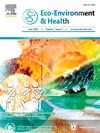农作物植物将形状不规则的矿物质颗粒从根部运输到嫩芽:跟踪和量化
IF 17.6
引用次数: 0
摘要
矿物颗粒在土壤中无处不在,通过携带养分和污染物影响作物的生长。虽然对溶解矿物质养分的吸收已得到证实,但不规则矿物质颗粒直接融入植物体内的情况仍不清楚。本研究采用水培和土壤培养的方法,调查了小麦和莴苣幼苗对高岭土颗粒(矿物质的代表)的吸收和运输情况。共价标记和高级显微镜显示,高岭土进入侧根萌发部位的根茎,然后被运输到嫩芽。荧光染料和镧(La)标记的高岭土颗粒表明,小麦在水培过程中对高岭土的吸收超过了莴苣,但这两种植物在芽中的颗粒含量相似。高岭土的转移因子(TFs)在土壤中(小麦为 0.089,莴苣为 0.039)明显高于水培植物(小麦为 0.001,莴苣为 0.003)。这些发现为作物植物直接吸收和运输高岭土颗粒提供了有力的证据。这为研究陆地生态系统中植物与矿物颗粒(包括其他胶体颗粒)之间的相互作用开辟了新的途径。本文章由计算机程序翻译,如有差异,请以英文原文为准。

Crop plants transport irregularly shaped mineral particles from root to shoot: Tracking and quantifying
Mineral particles, ubiquitous in soils, influence crop plant growth by carrying nutrients and pollutants. While the uptake of dissolved mineral nutrients is well-established, the direct incorporation of irregular mineral particles into plants remains unclear. This study investigated the uptake and transport of kaolin particles, representative of minerals, by wheat and lettuce seedlings using hydroponic and soil cultures. Covalent labeling and advanced microscopy revealed that kaolin enters root steles at lateral root emergence sites, followed by transport to shoots. Fluorescent dyes and lanthanum (La)-labeled kaolin particles demonstrated that wheat surpassed lettuce in kaolin uptake in hydroponics, but both plants showed similar levels of particles in the shoots. Translocation factors (TFs) for kaolin were significantly higher in soil (0.089 for wheat, 0.039 for lettuce) compared to hydroponics (0.001 for wheat, 0.003 for lettuce). These findings provide compelling evidence for the direct uptake and transport of kaolin particles in crop plants. This opens new avenues for research on the interactions between plant and mineral particles, including other colloidal particles, in terrestrial ecosystems.
求助全文
通过发布文献求助,成功后即可免费获取论文全文。
去求助
来源期刊

Eco-Environment & Health
环境科学与生态学-生态、环境与健康
CiteScore
11.00
自引率
0.00%
发文量
18
审稿时长
22 days
期刊介绍:
Eco-Environment & Health (EEH) is an international and multidisciplinary peer-reviewed journal designed for publications on the frontiers of the ecology, environment and health as well as their related disciplines. EEH focuses on the concept of “One Health” to promote green and sustainable development, dealing with the interactions among ecology, environment and health, and the underlying mechanisms and interventions. Our mission is to be one of the most important flagship journals in the field of environmental health.
Scopes
EEH covers a variety of research areas, including but not limited to ecology and biodiversity conservation, environmental behaviors and bioprocesses of emerging contaminants, human exposure and health effects, and evaluation, management and regulation of environmental risks. The key topics of EEH include:
1) Ecology and Biodiversity Conservation
Biodiversity
Ecological restoration
Ecological safety
Protected area
2) Environmental and Biological Fate of Emerging Contaminants
Environmental behaviors
Environmental processes
Environmental microbiology
3) Human Exposure and Health Effects
Environmental toxicology
Environmental epidemiology
Environmental health risk
Food safety
4) Evaluation, Management and Regulation of Environmental Risks
Chemical safety
Environmental policy
Health policy
Health economics
Environmental remediation
 求助内容:
求助内容: 应助结果提醒方式:
应助结果提醒方式:


